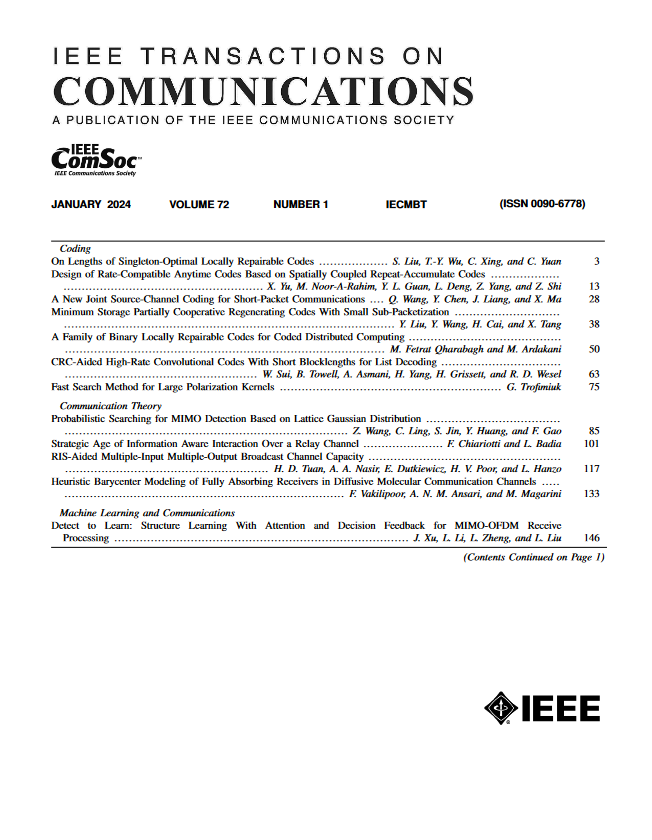The Gaussian Primitive Discrete Time and Filtered Diamond Channel: Correlated Noise and Dirty-Paper Coding
IF 8.3
2区 计算机科学
Q1 ENGINEERING, ELECTRICAL & ELECTRONIC
引用次数: 0
Abstract
We investigate the primitive diamond relay channel model comprising Gaussian channels with identical frequency responses from the user to the relays and with lossless fronthaul links with a limited rate from the relays to the destination. The model is further extended by addressing correlated noise at the relays, which can be present in the uplink system, for example, due to interference or a jammer. We use the oblivious compress and forward (CF) scheme with distributed compression, and the decode and forward (DF) scheme. The CF system rate is calculated for the correlated noise case and a closed-form formula is derived. The effect of positive and negative correlation on the system rate is shown. It is proved that CF-DF time-sharing scheme is advantageous over a CF-DF superposition coding (SPC) scheme for the correlated noise case. We also analyze another scheme to combine CF and DF, which is based on dirty paper coding (DPC). This scheme’s analysis relies on the correlated noise CF results, providing another motivation for examining this case. It is proved that also in this setting, the CF-DF time-sharing scheme is advantageous over the CF-DF DPC scheme. The optimal time-sharing proportion between CF and DF, and each frequency’s power and rate allocations are determined for positive noise correlation.高斯原始离散时间和滤波菱形信道:相关噪声和脏纸编码
我们研究了原始钻石中继信道模型,该模型包括高斯信道,从用户到继电器具有相同的频率响应,并且具有从继电器到目的地的有限速率的无损前传链路。该模型通过处理中继上的相关噪声进一步扩展,这些噪声可能存在于上行系统中,例如,由于干扰或干扰机。我们使用分布式压缩的无关压缩转发(CF)方案和解码转发(DF)方案。对相关噪声情况下的CF系统率进行了计算,并导出了封闭公式。给出了正相关和负相关对系统速率的影响。证明了在相关噪声情况下,CF-DF分时方案优于CF-DF叠加编码(SPC)方案。本文还分析了另一种基于脏纸编码(DPC)的CF和DF相结合的方案。该方案的分析依赖于相关噪声CF结果,为研究这种情况提供了另一个动机。也证明了在这种情况下,CF-DF分时方案优于CF-DF DPC方案。确定CF和DF之间的最佳分时比例,以及每个频率的功率和速率分配,使噪声呈正相关。
本文章由计算机程序翻译,如有差异,请以英文原文为准。
求助全文
约1分钟内获得全文
求助全文
来源期刊

IEEE Transactions on Communications
工程技术-电信学
CiteScore
16.10
自引率
8.40%
发文量
528
审稿时长
4.1 months
期刊介绍:
The IEEE Transactions on Communications is dedicated to publishing high-quality manuscripts that showcase advancements in the state-of-the-art of telecommunications. Our scope encompasses all aspects of telecommunications, including telephone, telegraphy, facsimile, and television, facilitated by electromagnetic propagation methods such as radio, wire, aerial, underground, coaxial, and submarine cables, as well as waveguides, communication satellites, and lasers. We cover telecommunications in various settings, including marine, aeronautical, space, and fixed station services, addressing topics such as repeaters, radio relaying, signal storage, regeneration, error detection and correction, multiplexing, carrier techniques, communication switching systems, data communications, and communication theory. Join us in advancing the field of telecommunications through groundbreaking research and innovation.
 求助内容:
求助内容: 应助结果提醒方式:
应助结果提醒方式:


